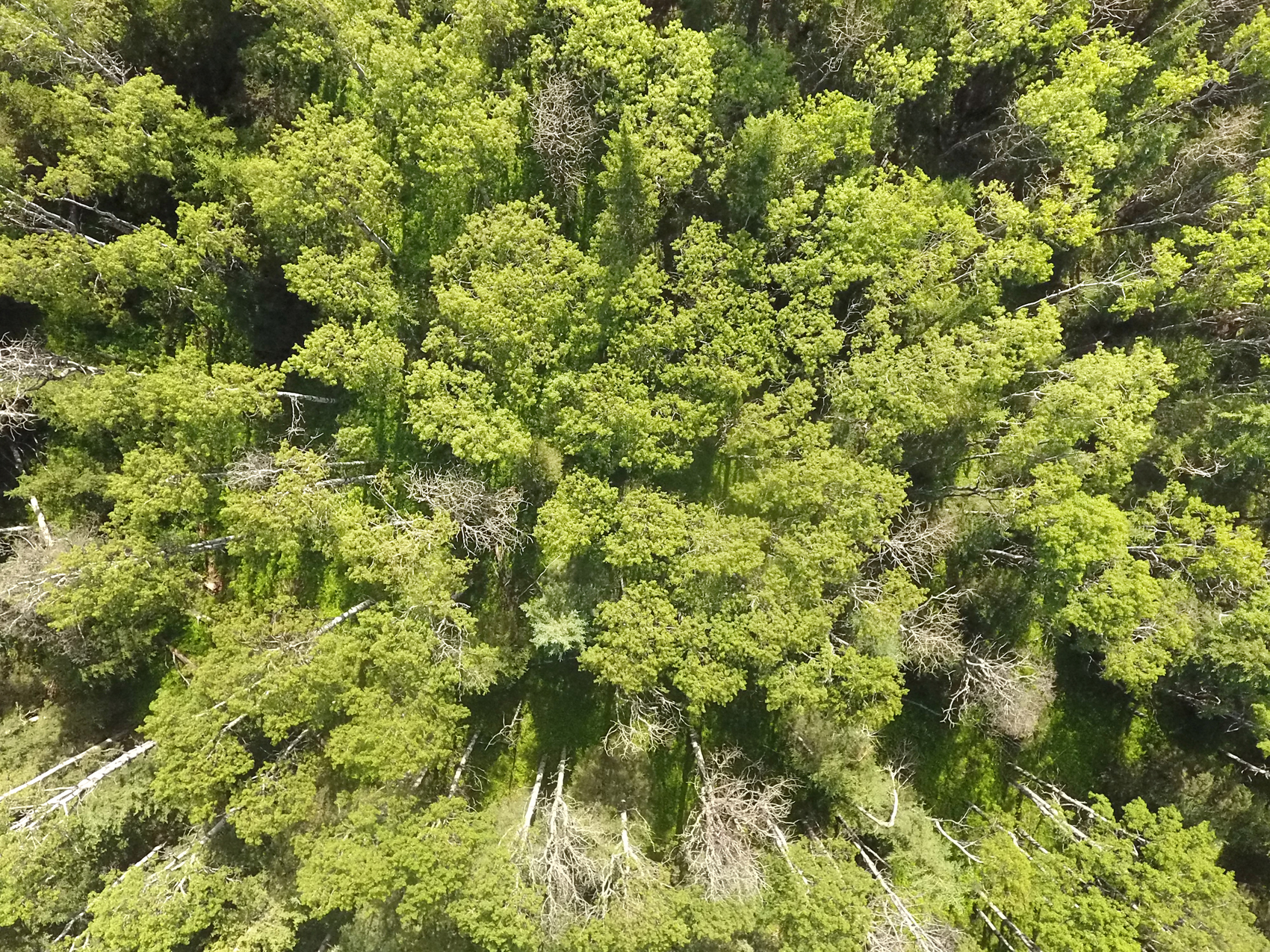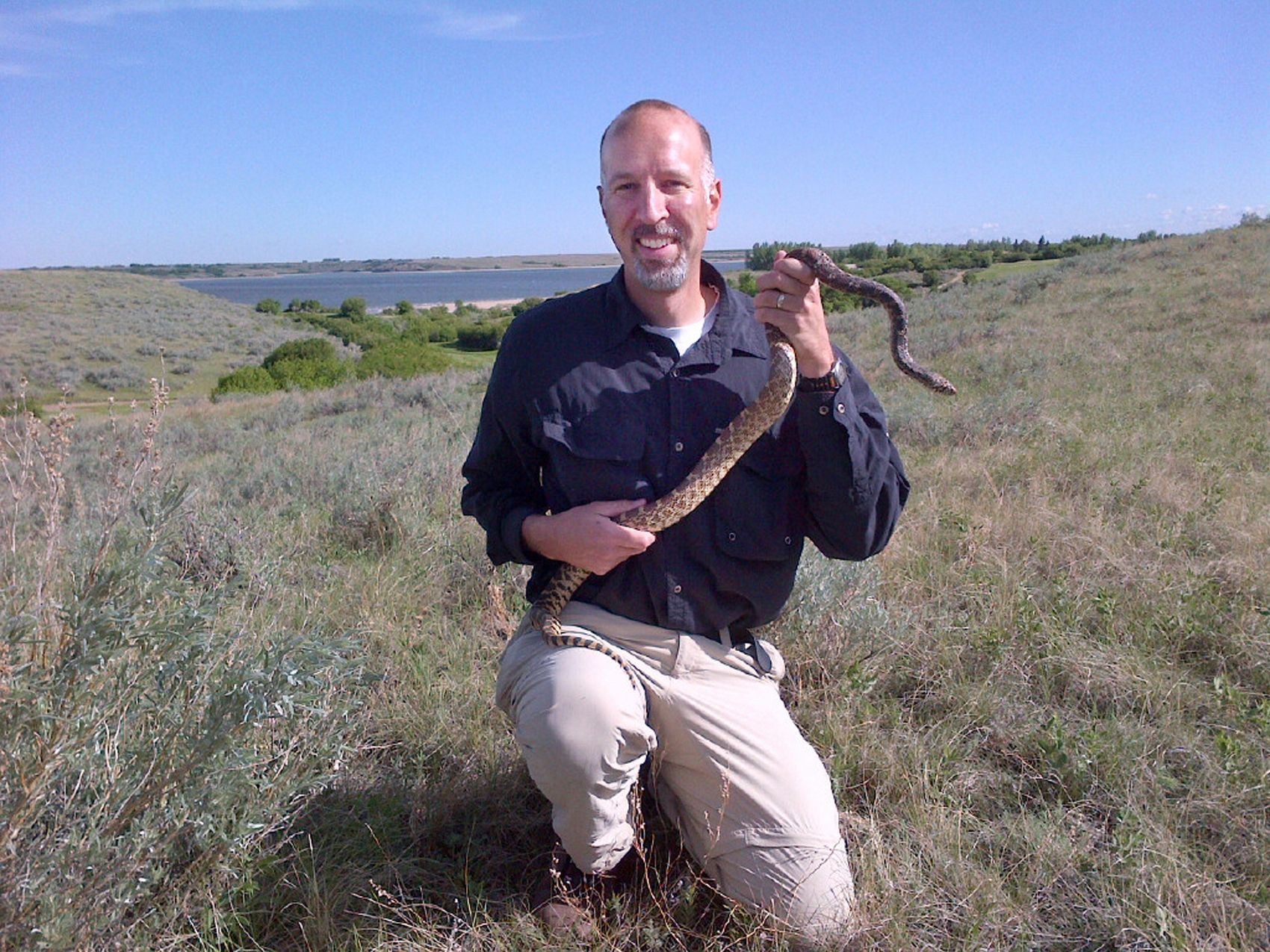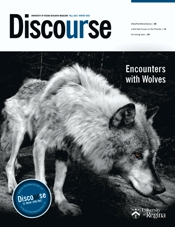The University of Regina field station in the Cypress Hills. (Photo by Anne Brigham)

Although it was 30 years ago, Mark Brigham still remembers what he thought the first time he laid eyes on the University of Regina’s research field station in the Cypress Hills.
“Why is it painted green on one end? Is it ever small. And, oh my, is it ever beautiful – it’s out of the way, and it will serve my purposes absolutely fabulously.”
The late George F. Ledingham, the former head of the University’s biology department, established the spot in 1973. Located in the middle of nowhere, 65 kilometres southwest of Maple Creek in the West Block of the Cypress Hills Interprovincial Park, the field station sits on 260 hectares of native prairie and forest on land leased by the University from the Province of Saskatchewan.

Accessing the field station means taking a trip through the Fort Walsh National Historic site – the property immediately adjacent to it. Its proximity is the reason half the trailer was painted green. Brigham later found out that Fort Walsh staff asked the U of R to paint it so that the trailer wasn’t as evident from the Fort’s Interpretive Centre.
“Its isolation – which, while it makes it the perfect spot to conduct field work – doesn’t mean it’s always easy to access. But, that’s also what makes it the perfect spot,” laughs Brigham, a University of Regina biologist who specializes in bat research.
“The first time I tried to go was on October 10, 1990. I had just been hired at the University and I immediately wanted to go out and see it. I hopped into a truck and headed west.”
But he didn’t make it.
“I got about 10 kilometres from the field station and couldn’t go any farther. It had been snowing and the roads are impossible to drive on in those conditions so I turned around and headed home. I finally made it there seven months later.”

The Cypress Hills are about 600 metres above the prairies and are one of only a few places not completely covered by ice during the Wisconsin glaciation period, giving it a unique climate and habitat. The vegetation is a mixture of fescue grassland and lodge pole pine, white spruce, and trembling aspen – making it the perfect research location for biologists of many stripes.
Every year for the last 25 years, Brigham spends a week in August at the field station with about a dozen undergraduate biology students from his upper-level animal behaviour course. “The field component is really valuable, and for many of the students, it’s the first time they have spent that much time in nature, collecting and processing data.” They also all live, eat, and work together – getting to know Brigham and each other.
Sometimes this close contact results in more than research.
The field station – three almost-50-year-old ATCO trailers attached together – has housed hundreds of budding biologists and established faculty members over the last five decades, and it has supported work that’s led to internationally significant discoveries. It’s even been the catalyst for love and marriage.
“I’m up to nine partnerships, with 10 children produced from those partnerships. And what I’m most proud of is that none of those relationships have dissolved. And some are going on 25 years,” says Brigham with a smile.
THE BATS, THE BIRDS, AND THE BEES
The partnerships that started at the field station, and the children born of those relationships, have even been memorialized on a special plaque.

The “Bats/Birds & Bees” plaque has two columns of names: “Pair Bonds” and “Fitness Units.” In biology, a pair bond is a relationship that develops between a mating pair for the purpose of reproduction and parental care of offspring. Fitness is a measure of an animal’s ability to produce offspring.
Of course, great research is another outcome of the field work conducted in the Cypress Hills.
Close to 100 journal articles, publications, conference talks, and manuscripts have emerged from the work done at the field station. A dizzying number of topics have been studied: from birds to bats, bull snakes to red squirrels, beavers to coyotes, from forest succession and plant communities, to resource management, drought, and environmental and climate changes on the Prairies.
In his field of bat research, Brigham says the work that he and his students have done has left an impression on people.
“The field station has allowed our scientists to explore the Cypress Hills in a way that couldn’t be done as easily in other places. We’ve been able to study the same place over a long period of time, which allows us to continually keep building on our research,” explains Brigham, who acknowledges that he and his students have an international reputation for their work on how bats cope with tough environments.
“Its isolation – which, while it makes it the perfect spot to conduct field work – doesn’t mean it’s always easy to access. But, that’s also what makes it the perfect spot.”
Brigham says that one of his first grad students, Matina Kalcounis-Rueppell – who is now the dean of science at the University of Alberta – started collecting data at the field station for her master’s degree in June 1993. The data required that she catch bats. But for months she didn’t catch a single one.
“She worked at it every single night. She set up nets, walked a huge number of kilometres carrying equipment, put in a lot of effort, and effectively got nothing from it. It was just bad luck,” he remembers. “It was hard for her and she wondered if she would have to change projects if she couldn’t catch anything, because if she couldn’t catch anything, she had no data, and with no data she couldn’t write a thesis. Then, on the August long weekend, she caught two bats. Those two bats led to others, which led to an important paper on how bats choose particular trees to live in.”
In the intervening 25 years, Brigham says a lot of the research that he and students have conducted has focused on how bats use and move between trees, and what they do when all the trees fall down or there’s a storm.
“Only by having people continually looking into these relatively simple questions have we been able to find the answers. I had no inkling when we started that we would have this kind of longevity of place with which to do research.”
It’s why people from all over the world who hear the words ‘Cypress Hills’ and ‘bats’ know the work has originated with Brigham and his students.
“The Cypress Hills is on a worldwide map, and that makes me really proud. It’s well known because of the very good work that comes out of there and virtually all credit goes to the students who have worked there.”
ANIMAL BEHAVIOUR
Kerry Hecker smiles in her pick-up truck as she gazes out over the native prairie at a buffalo rubbing stone at the Last Mountain Lake National Wildlife Area where she lives and works.
“The University of Regina’s field station changed my life,” says the wildlife area manager.
She says that while the tentacles of a possible biology career started to grab hold of her after her high school biology teacher took her class on some camping and canoeing trips, it was the field station that strengthened the grip.
“Ultimately, it was Mark Brigham’s animal behaviour class, with the field station component, that really set the course for my life. I feel like it was the bow and I was the arrow because that class, and the University of Regina biology program, are what got me launched in the right direction.”
“The Cypress Hills is on a worldwide map, and that makes me really proud. It’s well known because of the very good work that comes out of there and virtually all credit goes to the students who have worked there.”
Hecker’s first field job was in the summer of 1994. She was a second year student, and responded to a job posting for a field assistant to master’s student Matina Kalcounis.
“I went from doing bat work at the Cypress Hills field station with Matina, almost directly to Mark Brigham’s biology class.”
Hecker remembers watching the van full of students pull up to her granny’s house in Maple Creek, where she stood with a pile of veggies from the garden’s summer harvest.
“I was the last student to be picked up, and the only place to sit was beside this rather nice looking young man whose name was Lowell Strauss. He thought it was hilarious that I brought a bag of cucumbers with me,” laughs Hecker remembering that hot, August day.
Four years later, she ended up marrying Strauss. Their names – and their “Fitness Units,” Daniel and Jesse – are now etched into the infamous plaque.
“It was a really fun summer. And that course was my first taste of conducting field work for my own project. I had to work out all the logistics of trying to make something scientifically accurate, of isolating that one little thing that I wanted to test amidst the myriad things happening in the environment.”
From there, Hecker took full advantage of being a field assistant and spent her remaining undergraduate summers studying bats in the upper Carmanah Valley and the southern-most point of Vancouver Island, as well as studying phytoplankton and zooplankton communities in alpine lakes in Banff National Park.
“I didn’t mind working my buns off because I got to go to cool place and do amazing things,” says Hecker.
“My time at the University of Regina was exciting. I was even first and second author on a few refereed papers, which isn’t an opportunity an undergraduate student would probably get at a larger university.”

Hecker now manages both the Last Mountain Lake National Wildlife Area and Migratory Bird Sanctuary (Canada’s oldest bird sanctuary) and the Stalwart National Wildlife Area for a combined total of more than 16,000 hectares of federally protected land.
Her work managing the area protects and supports water and grassland birds and other wildlife, as well as their habitat, which includes the habitat for millions of migrating shorebirds and many at-risk species, including the ferruginous hawk, the piping plover, the whooping crane, and the peregrine falcon.
Hecker is passionate and enthusiastic about her work and the role she plays in conservation. She also knows that she wouldn’t be where she is today if the summer of 1994 didn’t play out the way it did.
“The field course, doing research with Matina, and meeting the husband – bam, bam, bam – all those things in quick succession really set the course of my life. And here I am,” she says with a satisfied smile.
INTERNATIONAL AFFAIRS
This past summer, Paco Vega spent his week at the field station conducting research into the foraging behaviours of chickadees. Like Hecker, and the hundreds of students before him, Vega was excited to be conducting his own field work in the Cypress Hills.
“I am a field biologist, so when I thought about my study abroad year, I decided to take an animal behavior course. When I looked at all the places that my home university had agreements with, the University of Regina, with its field station, was my first choice,” says the fourth year undergraduate student on exchange from the Universidad Autónoma de San Luis Potosí in Mexico.
Vega says looking at a completely different ecosystem than at home in Mexico was only part of what made for such a rich experience.
“Part of the course involved a public presentation at the Cypress Hills Centre Block, which was a great opportunity to talk with the public and for me to improve my English.
“And staying at the field station helps you to really get to know your classmates. We had a lot of time to exchange ideas and chat,” says Vega. “Our projects evolved because we provided each other with feedback. Plus, we had the opportunity to have almost all of our meals together – and sharing a meal is always a great way to start bonding.”
Vega was also quick to point out that it was a bonus to have the chance to talk with more experienced students, because both master’s and PhD students were on site during the animal behavior course.
Set to head back to Mexico in December, Vega says that experiencing different cultures and learning from them was something he wouldn’t have gotten if he hadn’t made the trip abroad. “And participating in an exchange also makes you appreciate what you miss. I miss my family…and the food,” he laughs.
IN THE TREES
Like Vega, Dana Green says it was almost a given that she would travel north to the University of Regina from her home state of Missouri to complete her PhD.
In 2015, when Green was still an undergraduate student, she travelled to the American Society of Mammalogists conference where she met Erin Baerwald, who, at the time, was a postdoctoral fellow working on bats with Brigham.
“I later met Mark Brigham, came up with a great project idea, and given that the University of Regina has an international reputation for its bat research…here I am,” says Green.
The field station also played a critical role in her decision to choose the U of R.

“It’s nestled in a bowl surrounded by rolling hills of grassland and shrubland, aspen and spruce. And while the field station doesn’t look like anything special, once you go inside and see the walls covered with the signatures of researchers who worked in the field station before you – people whose papers you’ve been citing for years – and you see that this is where they did their research, well, it’s very magical,” says Green, adding that it’s rare to have such accommodations for students (the field station has a bathroom, kitchen, and six bedrooms with bunkbeds).

“Knowing that there is a place where researchers – from undergrads to faculty members – can stay and interact with the environment and wildlife, and simply have a place to call home while actively doing our field work is extremely enticing.”
In the summer of 2019, Green started her work on discovering more about bats’ ability to orient themselves, research that scholars around the world are only now starting to dive into.
“We know how birds do this, but not bats.”
Green says her research will involve catching bats in nets, feeding them “oodles and oodles of meal worms,” then releasing them the following night. Her hypothesis is that when they are full, instead of flying to find food, they will fly for migration purposes, as has been shown in other species.
Green is also working closely with master’s student Adam Sprott, whose work is building upon all of the work that’s been done at Cypress Hills over the several last decades.
“My main goal was to work – using drones – with forestry and wildlife,” says Sprott, who works closely with both Brigham and his supervisor, University of Regina forest ecologist Mark Vanderwel.

Sprott is studying how water limitation affects biomass in trees, as well as how bats use different habitats.
“For me it’s about pushing the limits of new technology,” says Sprott. “I’ve been really excited to use a drone that’s affordable and accessible – it’s off the shelf and you can take it anywhere, which means it could go to any country and people could see how their forests are developing for their management plans. But I also use a fancy drone that looks at thermal and infrared aspects.”
Sprott says that drones brought him to the University of Regina because Vanderwel was using them in his research.
“Using drones in their infancy for this type of research is exciting. Being able to look at and build on research with bats since 1995, while also bringing new technologies and innovation to that field, is also exciting.”
Sprott says that the field station has allowed him to do far more in-depth research than somewhere without such a facility, which really puts the University’s biology department’s research on another level.
“It’s a natural laboratory that lets me collect a great volume of data. Plus, I feel as though we are like a bunch of astronauts way out in a field, in a remote area, in a field station where we all eat together and work together. It’s a little microcosm. And here we are, in the middle of a beautiful, amazing place – an isolated little pocket of scientists.”

BULLSNAKES
Beyond that pocket are acres and acres of land cared for by ranchers who have a deep respect for the land and the animals that live on it.
Chris Somers, a University of Regina biology professor, says that, from his experience, ranchers are often conservation minded.
“Their living comes from the land they manage so they don’t want to take missteps that would cause their land to be less productive or reduce their ability to graze livestock. They often take great pains to keep their native grasslands functional, which involves keeping native species and communities intact. So a lot of them have a great fondness for animals you wouldn’t predict – like bullsnakes.”

Somers and his students appreciate ranchers’ care for the snakes because their research is on those constrictors, the largest snake in Canada (bullsnakes in Saskatchewan will grow to roughly 2 metres in length, with the biggest bullsnake Somers has encountered weighing in at about 3 kilograms).
“The bullsnake is at risk of being driven out of Canadian territory,” says Somers. “But they are living and thriving in the Cypress Hills region, and not in other areas of the province, and we are trying to understand why.”
Unlike many of the other researchers whose work keeps them relatively close to the area around the field station, Somers and his team –including Ray Poulin, the curator of vertebrate zoology at the Royal Saskatchewan Museum – conduct their research further afield.
“We rely extensively on the goodwill of landowners because we tend to find a lot of bullsnakes in the areas around Maple Creek,” says Somers. “Most of the ranchers we work with are keen to have the snakes on their land, and we love that, because half the battle our team faces is helping people see them as animals that are worth something. So if the people who own and live on the land already understand that, we’re in a position to start sharing knowledge with each other.”
Somers says one of the great things about bullsnakes is that they are non-venomous, so people aren’t as afraid of them as they are of rattlesnakes. Moreover, because they eat small mammals, they are great pest control – hence the love affair ranchers have with the bullsnake.
“If a rancher has a shed full of mice, there’s nothing better to take care of them than a big ol’ bullsnake. And, if you happen to have 20 bullsnakes on your property, your problem is gone,” laughs Somers.
"And here we are, in the middle of a beautiful, amazing place – an isolated little pocket of scientists.”
Despite not working in the area directly near the field station, Somers says the U of R’s ATCO trailers still play an important role in their research.
“Besides being a cheap place for students to stay, the field station gives them access to that beautiful native prairie country,” says Somers. “Plus, because a bunch of students and scientists stay there, students have the chance to interact with folks who have different perspectives. They bounce ideas off of each other, discuss statistical techniques and data collection methods, and really form a community that they otherwise wouldn’t have access to. It’s the community learning aspect that goes above and beyond the idea that the field station is simply a place to sleep.”
A PRAIRIE HOME
Brigham smiles when he says that he could talk about the field station forever, and freely admits that the greatest impact has been its role in bringing together the amazing people with whom he has worked.
“There are just some extraordinarily bright and capable people who have felt, similarly to me, lucky to be able to spend time, or their entire summers here, doing the research they have done, and doing it very, very well.”
All these years later, Hecker also feels fortunate for the field station.
As she walks around the Last Mountain Lake Wildlife Area on a crisp November morning, Hecker reflects upon her career as a biologist. “In many cases, people who get into biology almost have a vocation. It’s something they’re passionate about, either for altruistic reasons, or simply because they see the conservation side of it as necessary. That focuses people and it encompasses their whole lives, not just what they do for a living. I certainly feel that way.
“And if I hadn’t taken those few steps in the right direction in my University of Regina days, I wouldn’t have had the skills I needed to do the work I’m doing. So, when opportunity knocks, you have to be able to open the door. I had the tools to open that door, and ended up here – at home, in the deepest sense of the word. I can honestly hold up having had access to the field station, the biology department, and Mark Brigham as responsible for that.”
Quite a legacy for a little field station on the Prairies.
Check out this video about the field station:












